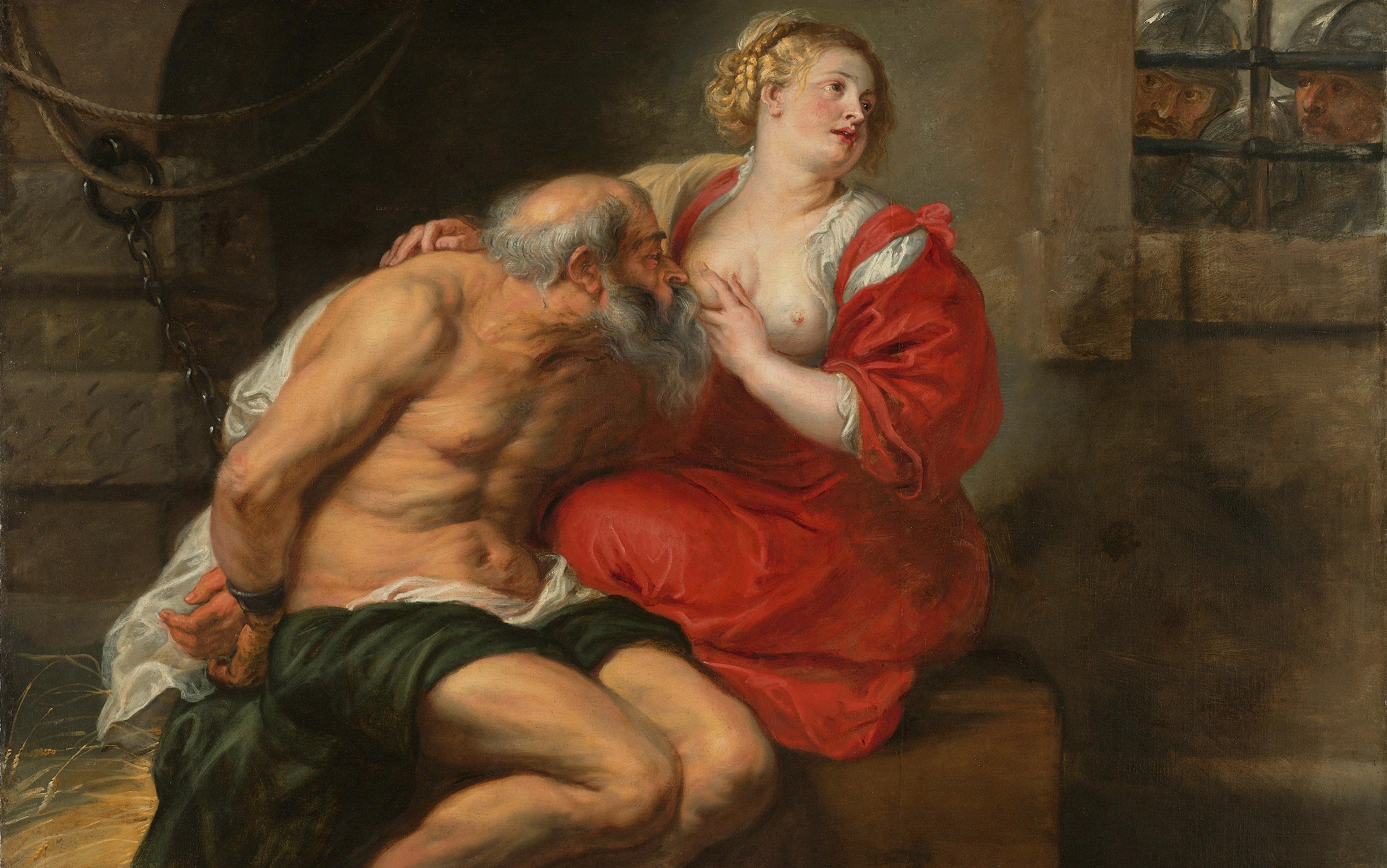The young woman’s sumptuous crimson dress is unbuttoned. Her exposed breasts, painted in gleaming, creamy flesh tones, invite caress: they are the focal point of the painting, magnetising our gaze. Even if we manage to look away, how can we ever unsee the grey-bearded man, his mouth greedily attached to one breast, his eyes fixed on the rosy nipple of the other?
Roman Charity is an image of voluptuary horror. Twisting her face away from what is being done to her, the young woman gazes desperately beyond the frame, her body tensing. There is no bliss here, no reciprocity, no pleasure, no air. Is she signalling for help, or just desperate that nobody witness her entrapment? But there are witnesses of course. I am one, you are another. There have been innumerable others since 1625 when Peter Paul Rubens painted this scene with all the sinuous carnality for which he is renowned.
This suckling man, naked except for the black cloth draped across his groin, is marked as virile. There is an erect nipple on display on his bare chest. His sinewy arms are strong. He could still wield a sword, except that his hands, twisted behind him, are manacled, chained to the wall. It is only when one follows the gleaming links through the shadows that one sees the metal grille, behind which men leer at this abject spectacle. They are helmeted – soldiers or guards.
This is a public prison not a domestic one. And though the man is shackled, it is the woman, swathed in her ocean of red silk, who is unable to escape. Even as she averts her eyes from the sight of this awful, shameful, inescapable suckling, she rests one hand on the old man’s shoulder. Here tenderness, pity, perversity, fear and love compete. Hers are invisible bonds.
This scene of disorientating and regressive perversity, of a woman trapped – her body in service to nurture without limit – feels shockingly familiar. I feel it in the young woman’s body language, a silent scream of ‘Get me out of here!’ What would she say to me, I wonder, if she could use a language other than the language of the body and its fluids?
What women say and don’t say was in the forefront of my mind when I first saw this strange painting in 2016. At the time, I was drafting a manifesto for women writers for the free-speech organisation PEN International, so I had the following questions in mind: why is women’s creative legacy so easily lost to the canon? Why is the authority of women – our self-authorship – so difficult to establish, then pass on to our future daughters? Why do we hear silence when we know there are words? How are women disappeared? This disturbing painting embodied a psychic truth about the intimate politics of patriarchal relations between men and women that I needed to metabolise.
I could not see this sinuous Baroque painting as a classical allegory, the way a wealthy Florentine or Flemish bishop or merchant or nobleman would, the better to evade the censors. All I saw was a stricken young woman with an old man battened like a tick onto her body. I could not look at her without thinking of the countless women who have been feasted on and silenced by men, for whom women’s bodies feed and sustain their sense of power, authority and invincibility.
I have learned enough from Sigmund Freud and Michel Foucault to know that history can clarify things, which is why I went in search of the origins of Roman Charity, but I could find very little. The only full-length monograph on the subject is Jutta Gisela Sperling’s book Roman Charity: Queer Lactations in Early Modern Visual Culture (2016). Her investigations were prompted by a similar response to mine – a confusing repulsion-attraction that made it impossible for her, as for me, to look away from this perverse image. Sperling, a cultural historian of the early modern period, gives a marvellously fecund and subversive account of the image, replete with its unstable and shifting meanings – its queering of social and sexual relations. She looks at how these often eroticised and disturbing images of lactation conjure other (often repressed) relations of power, desire and matrilineal connection that disrupted and troubled the patriarchal system of kinship being established in the early modern period. I am indebted to Sperling’s wide scope and detailed analysis of Roman Charity as it relates, in particular, to the legal and social world that produced these images. But I’m also interested in looking at them from my own second-wave feminist vantage point in the present. Roman Charity reveals something fundamental about the troubled gender relations of the present. I have not wanted to lose the feeling of shock and recognition I felt on first encountering these paintings: the elision of the distance between sexuality and food.
The first record of Caritas Romana is a written account of a daughter breastfeeding her impoverished and imprisoned mother. Valerius Maximus, a 1st-century Roman historian, tells us that:
A plebeian woman of low position who had just given birth to a child, had permission to visit her mother, who had been shut up in prison as a punishment, and was always searched in advance by the doorkeeper to prevent her carrying in any food. She was detected giving her mother sustenance from her own breasts. In consequence of this marvel, the daughter’s pious affection was rewarded by the mother’s release, and both were awarded maintenance for life.
It was a delight to have care – that form of embodied love, almost always performed by women, almost always made invisible – presented as a rebel daughter’s radical act. But there’s an undercurrent in the story of prurient patriarchal unease. The guards, Valerius Maximus tells us, at first wondered aloud if they had witnessed a titillating act that went ‘against nature’. Only after lengthy discussion do they decide that what they’d seen was not an act of incestuous lesbianism, but a demonstration of a dutiful Roman daughter obeying the first law of nature: to love her parents. Pliny the Elder records that a temple dedicated to the goddess of Piety was built in these two women’s honour where the prison once stood. It was at this site that freelance Roman wetnurses went to sell their milk services – a reminder that milk was both an extrafamilial commodity and a fluid that created different kinds of lines of connection to blood. No classical depictions of this law-defying act of daughter-mother nurture have been found – and there are vanishingly few in the Common Era. There are, however, many images on coins and frescoes that show a daughter feeding her father.
Where the daughter could feed her mother as an act of freedom, feeding her father is imbued with fealty

An ancient Roman fresco of Roman Charity in Pompeii (45-79 CE). Courtesy Wikipedia
With a narrative speed that is striking, the mother-daughter couple is pushed aside, and Maximus swiftly moves on to tell a different, patriarchal version of this tale of filial devotion, in which the couple are named Pero, the dutiful daughter, and Cimon, the suckling father incarcerated for an unspecified crime and condemned to death by starvation. This was the story that was to become dominant in terms of visual representation: the father usurped the mother’s place. But this is not a like-for-like parental substitution. The relationship between a mother and her children, part of the law of nature, was not codified in Roman inheritance law, which meant that a mother could not leave anything to her daughter. A woman’s children were not hers. Meanwhile, a father’s relation with his children was codified in civil law: they could inherit from him. They were also, in effect, his property. The paterfamilias had all rights, including the right of life and death, over the members of his household. For the daughter, this defines the meaning of her giving and her father’s receiving.
Where the daughter could feed her mother as an act of freedom or rebellion, feeding her father is imbued with the relation of fealty.
I had a flash of body-memory when I read Sperling’s claim that Maximus’s twin anecdotes ‘participate in [a] visual and religious universe in which the depiction of breastfeeding stresses ritual or symbolic, not biological, maternity.’ It reminded me that the domesticated art of breastfeeding was once a promiscuous business. Milk leaks outside of and dissolves the closed lineages of blood-relations. I have fed three of my own children, but I have also fed another woman’s desperately hungry son. My friend went out and left her baby in my care. The tiny boy began to wail. So, to soothe him, I lifted up my top, stepping into one of the most ancient roles – that of wetnurse. He latched on, drinking what I had until then thought of as my birth-daughter’s milk. It surprised me at the time how natural – that complicated word for things we think of as being outside of culture – to allow a hungry but unrelated creature to feed from my body. I have thought of him as a kind of son ever since.
It is tempting to speculate that the original mother-daughter vision of Caritas Romana gives us a glimpse of a kinship system defined by milk lines rather than the blood lines of agnatic, or paternal, kinship. This tale that harks back to older goddess-centred cults and religions reminds me that Caritas Romana is not the only Roman tale of a life saved by the milk of its not-mother, the best-known being that of Romulus and Remus, the founders of Rome: twin sons of the god Mars and the mortal Rhea Silvia, who were suckled by a she-wolf. There are also lactation tales that imbue the recipient with divine powers, demonstrating ancient beliefs in the magical power of breastmilk. One is writ so large that it has given the most spectacular feature of the night sky its name: the Milky Way. Tintoretto’s The Origin of the Milky Way (c1575) shows the infant Heracles being surreptitiously latched on to the goddess Hera while she sleeps. Heracles, the son of a mortal woman, apparently sucked so hard he woke the goddess who dashed him from her breast. Hera’s divine milk, which afforded him the immortality of the gods, then sprayed across the heavens and formed the Milky Way.
The tradition of adult breastfeeding as a cure is evidence of the ancient belief in the magical power of breastmilk
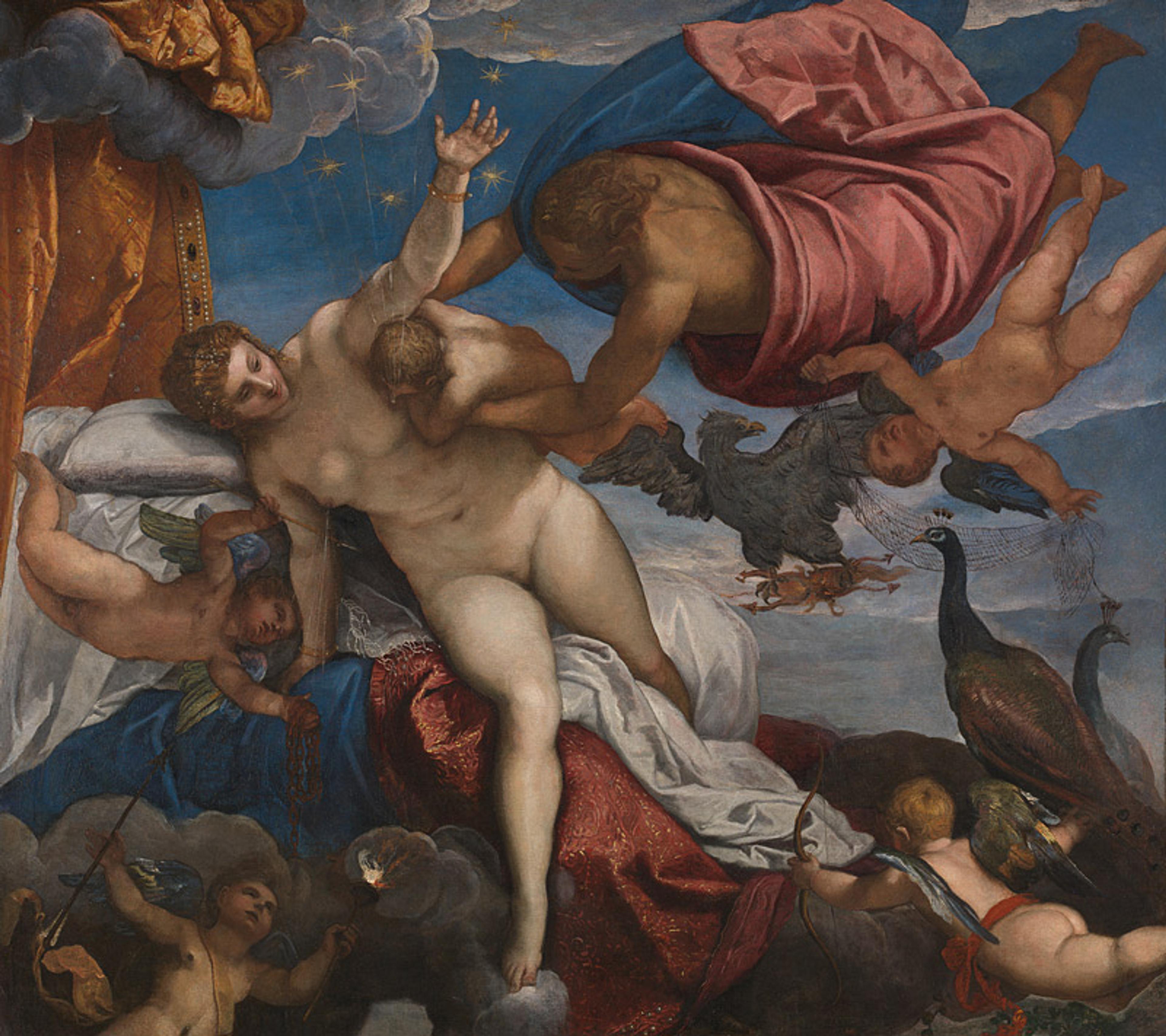
The Origin of the Milky Way (1575) by Tintoretto. Courtesy the National Gallery, London
The abundance of milk is present in images of phantasmagorical plenitude and eroticism. Suckling nymphs and multibreasted mermaids and goddesses abound, portraying an extravagant delight in this extralinguistic world of flesh and bodily satisfaction. Images like Giulio Romano’s fantastically tailed mer-mother and her mer-babies give the slip to the realities of sexual reproduction and the constraints of family and of species.
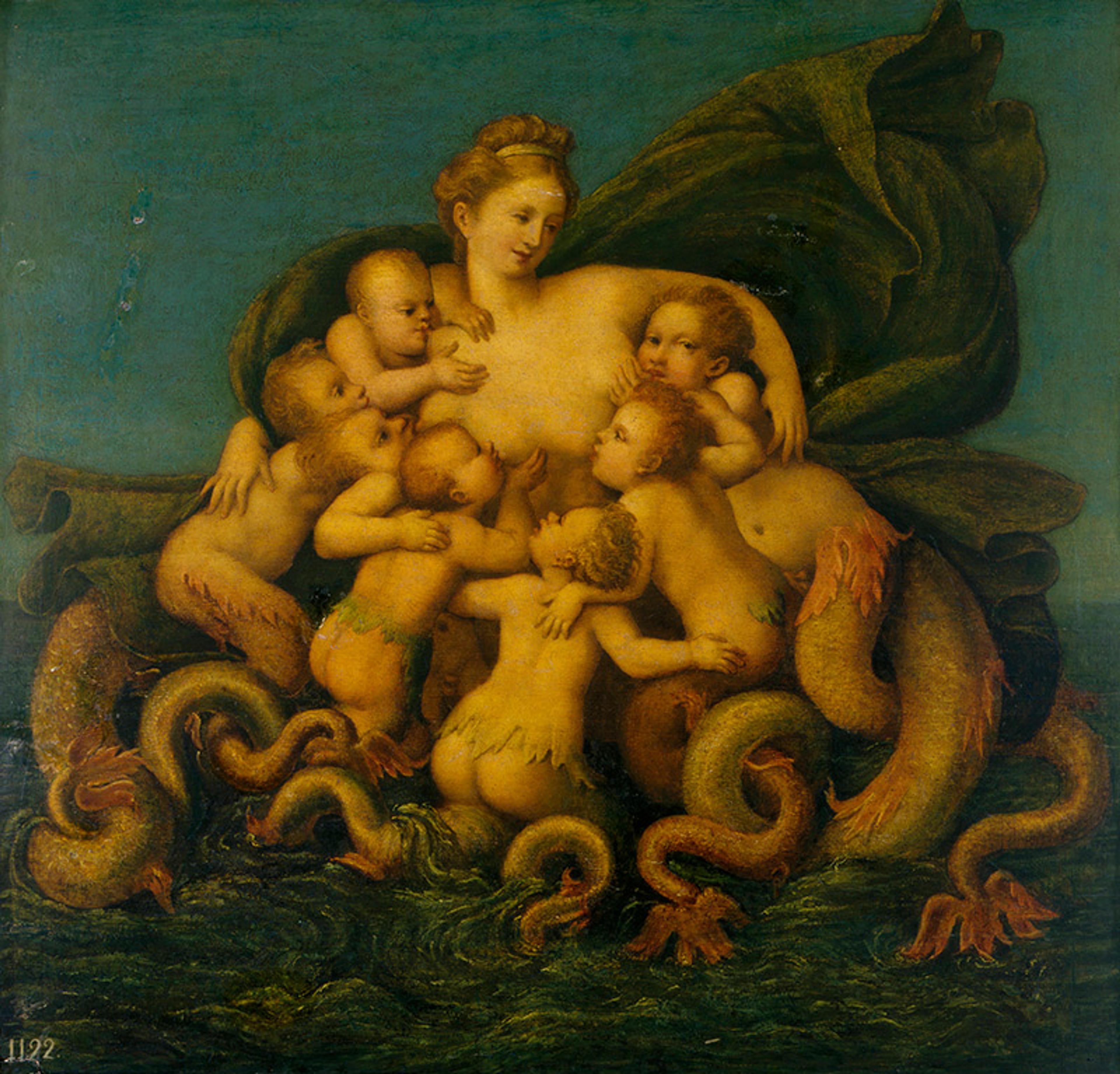
A Mermaid Feeding her Young (c1520-40) by Giulio Romano. Courtesy the Royal Collection
The pagan breasts of powerful goddesses, their magic and their healing power, were assimilated into Christian beliefs and imagery, and so the veneration of lactating goddesses lived on in Catholicism. The scene of filial piety described in the original version of Roman Charity became linked to the Christian virtue of charity, which was customarily represented as a breastfeeding woman. The Madonna nursing the infant Jesus, the ur-image of maternal-divine care, became central to representations of the Roman Catholic Church. There was even a tradition of adult breastfeeding as a cure, evidence of the ancient beliefs in the magical power of breastmilk. Pope Innocent VIII was prescribed a young woman whom he suckled in the time before his death in 1492.
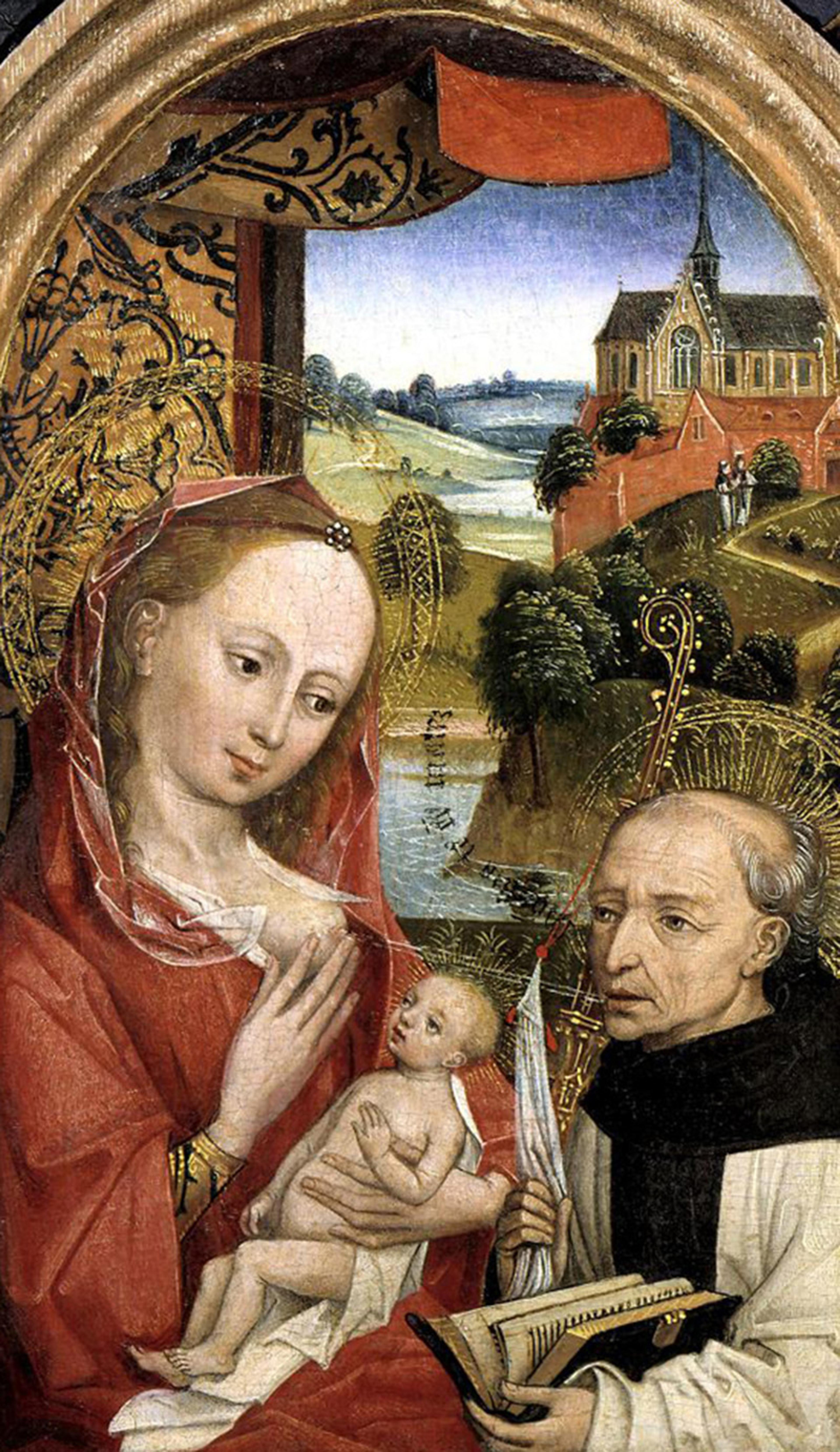
The Lactation of Saint Bernard (c1480), artist unknown, Flemish school. Courtesy the Curtius Museum, Liège
Renderings of the Madonna Lactans, or Nursing Madonna, in which one of Mary’s breasts is exposed, her milk standing in for the spiritual succour of the Church, became ubiquitous during the medieval period. Perhaps one of the most beautiful images of the pure, healing breasts of the mother of God, the intercessionary mother, is Leonardo da Vinci’s Madonna Litta (1490-91), in which he combines an exquisitely natural depiction of an ordinary mother feeding her infant with an evocation of the divine.
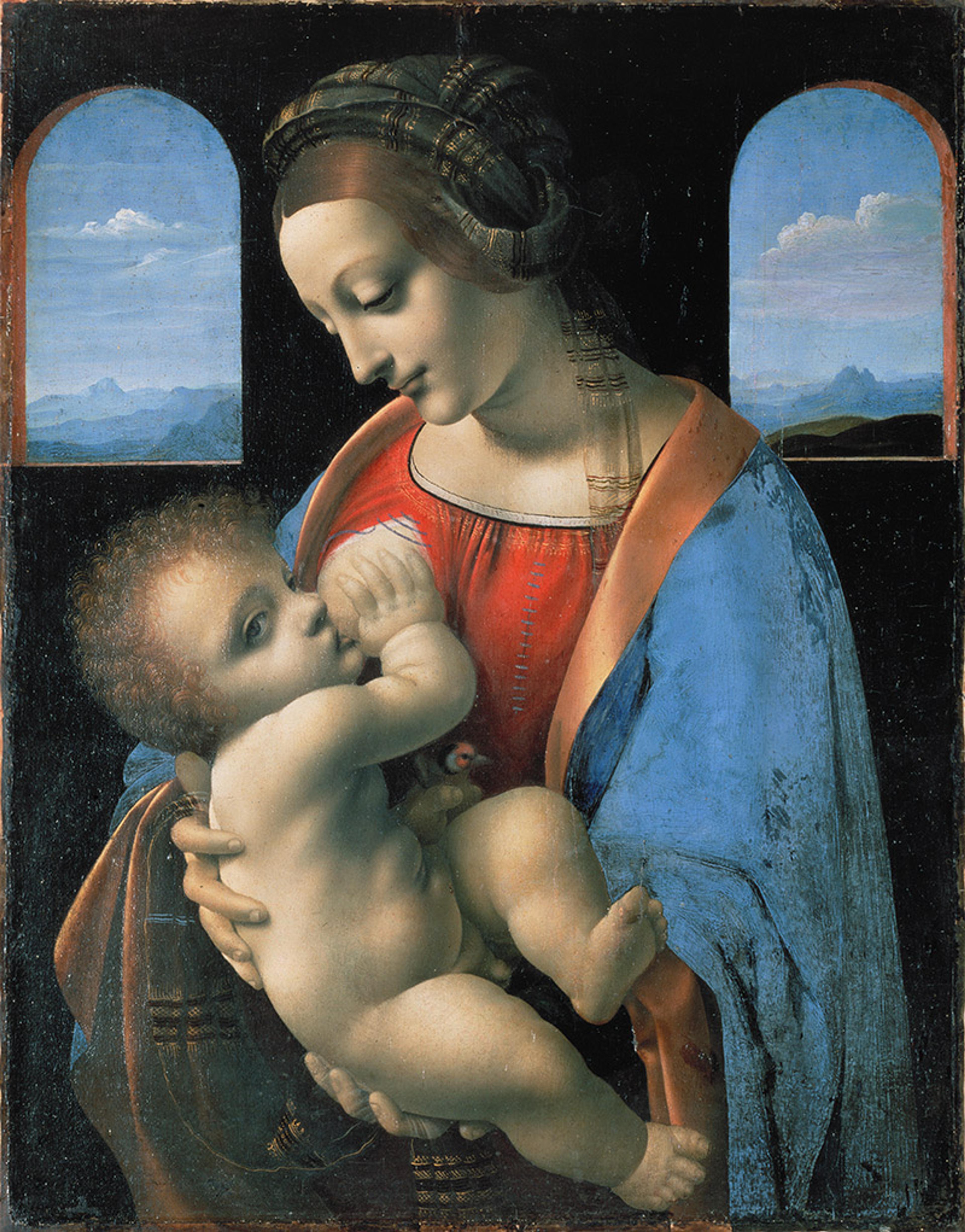
Madonna Litta (1490-91) by Leonardo da Vinci. Courtesy the Hermitage Museum/Wikipedia
For a time, a parity of fluids – the Virgin’s milk and the blood of Christ – were entwined in religious imagery, in worship, and as a means of accessing the divine. The erotic masochism – the pierced, tortured, leaking Christ, whose blood nourishes his followers, as Madonna’s milk nourishes those she suckles – was a staple of medieval and Renaissance Christian imagery. In Quirizio da Murano’s painting The Redeemer and the Nun (1475), the Christ figure offers his wound/breast to a nun, his fingers in a V shape around his nipple in the classical pose of a woman breastfeeding.
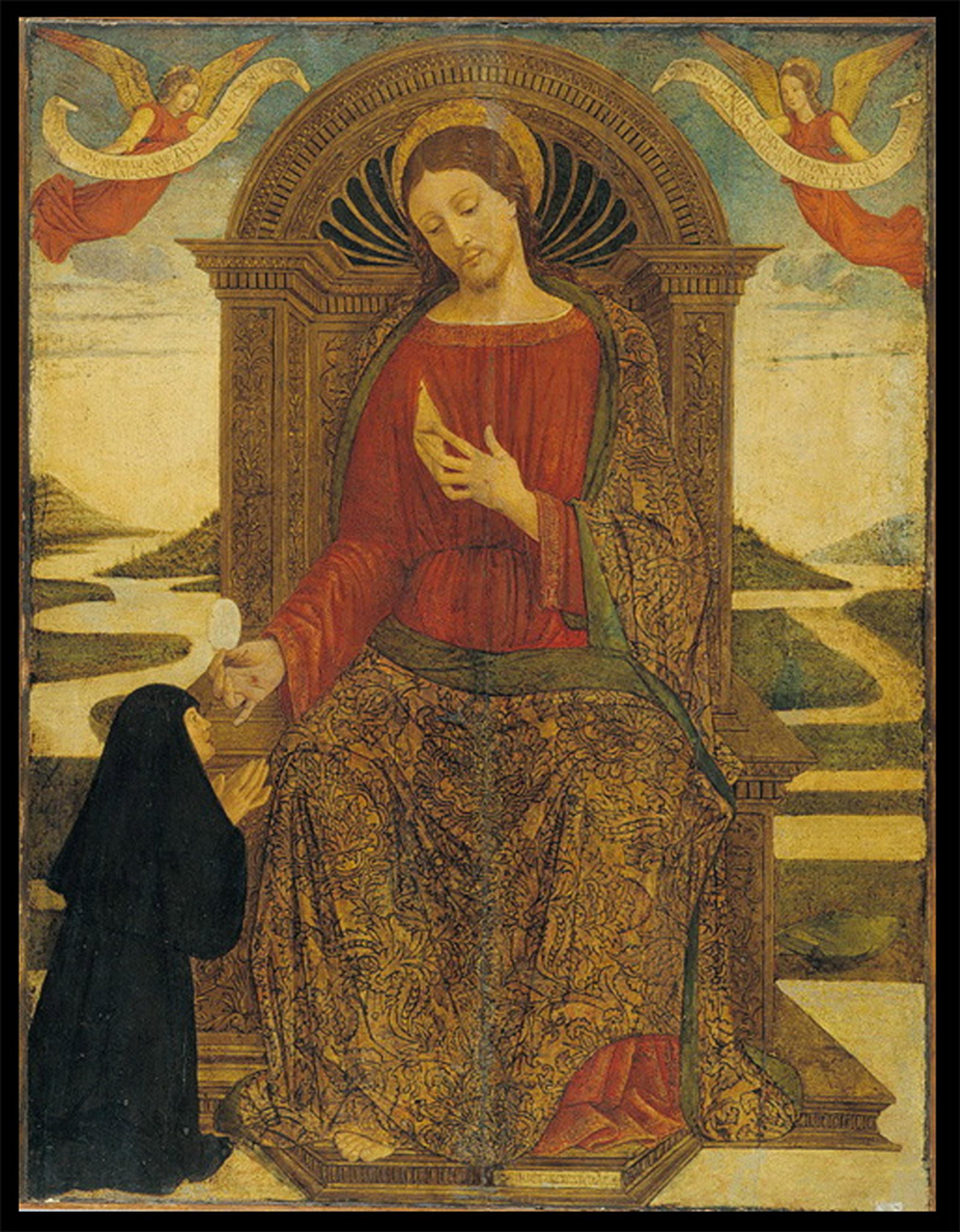
The Redeemer and the Nun (1475) by Quirizio da Murano. Courtesy the Gallerie dell’Accademia, Venice
The beautiful Madonna Lactans – one ripe breast fully exposed – was a popular subject, but the holy and the erotic made for uneasy bedfellows, especially with the increased realism of these paintings. In the Virgin and Child with Angels (c1452), Jean Fouquet is said to have painted Agnès Sorel, mistress of Charles VII of France, as the Madonna. This disguised portrait marks the blurring of, if not a transition from, the symbolic holy breast to the erotic breast of a powerful man’s lover.
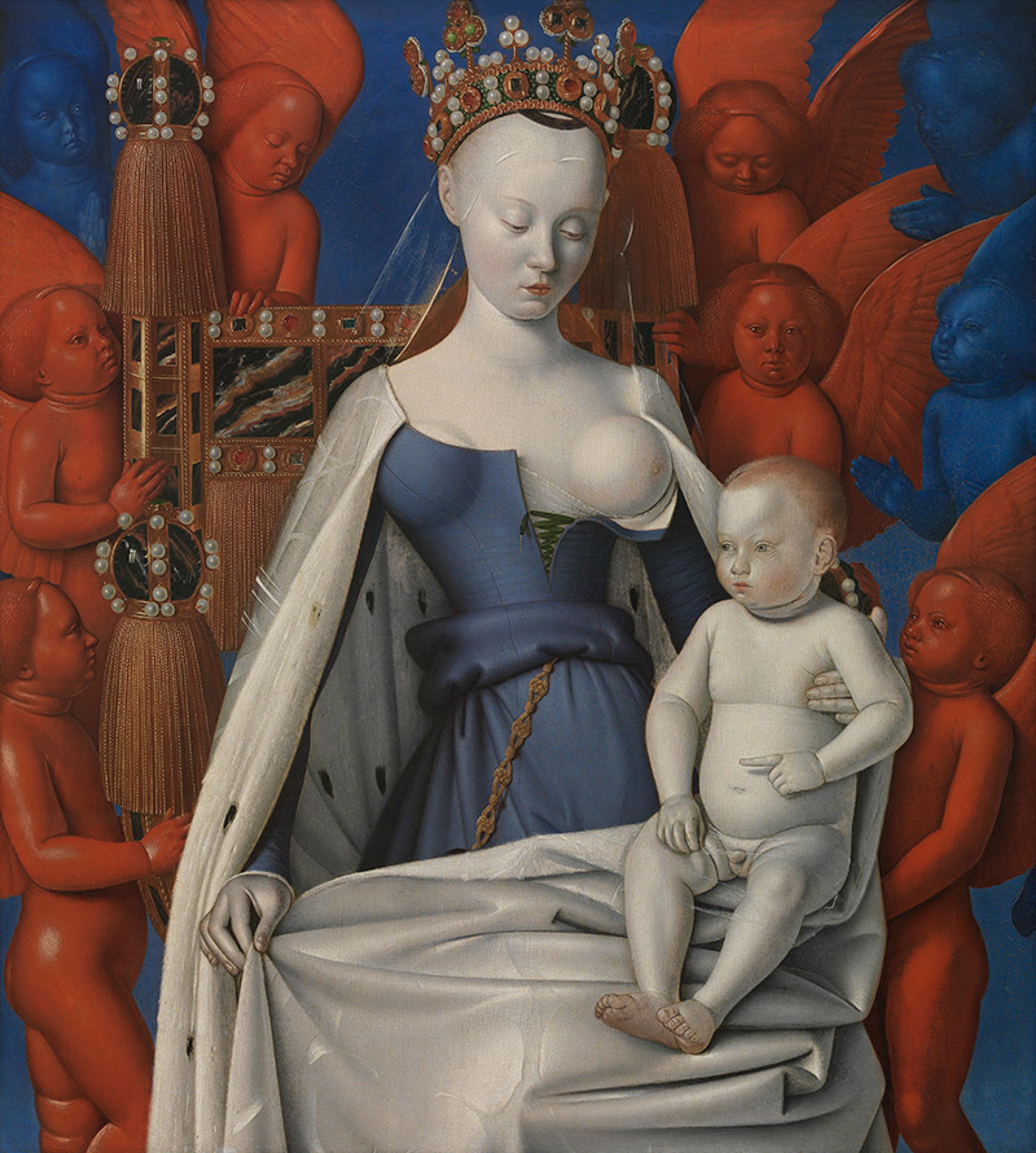
The Virgin and the Child with Angels (c1452) by Jean Fouquet. Courtesy the Royal Museum of Fine Arts, Antwerp/Wikipedia
A century later, as the Reformation gathered pace, the German brothers Barthel and Sebald Beham produced several lascivious renditions of Roman Charity, one of them openly pornographic. The Behams repudiated the hypocrisy of representing titillating subject matter through veiled classical subjects. In one image, while Cimon is clothed, with hands shackled behind his back, a breastfeeding Pero stands seemingly naked, her pubis shaved and everything on show through a piece of cloth so transparent as to satirise the very conventions that enabled this display of thinly disguised classical figures. Here, Pero is as upright and erect as any dominatrix, while she pushes her pointy nipple into the eagerly submissive Cimon’s mouth. The sexual is palpable in the Behams’ images – and the truth of illicit desire, and of incest, is undeniable. The brothers Beham paid for their honesty by being jailed for atheism.
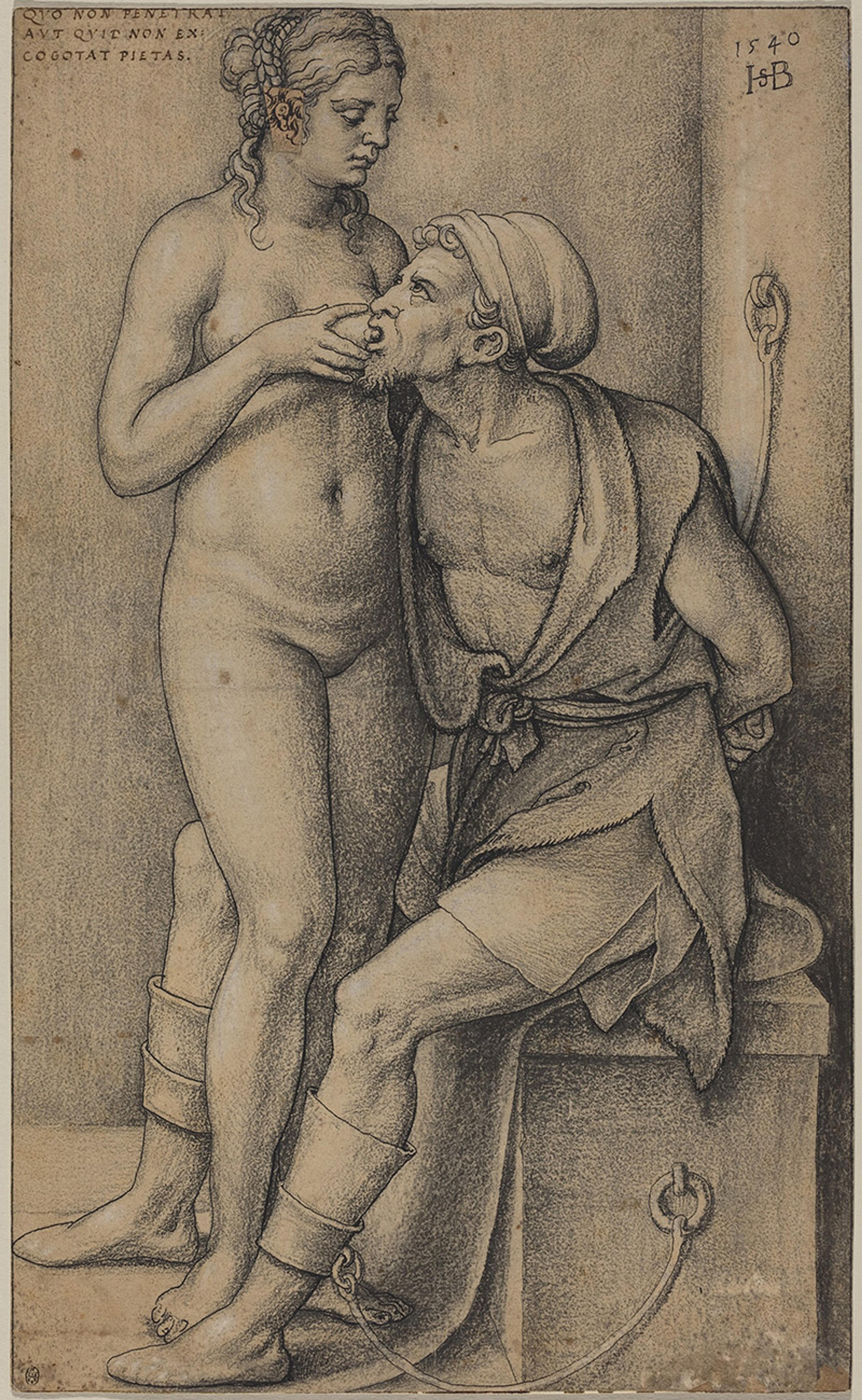
Cimon and Pero (c1540) by Sebald Beham. Courtesy the National Gallery of Art, Washington, DC
The trouble between the ecclesiastical authorities and the provocative Beham brothers presaged the religious conflict that exploded with the reforming zeal of the Protestant Reformation. This prompted the Catholic Counter-Reformation – and Baroque art, dating from the early 1600s, was part of the pushback against Protestantism. A populist and sensational form of ecclesiastical art, it was intended to appeal directly to the senses. The aim was to attract congregants, lured away by the reforming fervour of the newly formed Protestant churches, back into the Catholic fold. The Baroque style is defined by vivid images – dense, loaded, crowded, full of movement, and Caritas Romana – the Latin title fig-leafing the creepy made-you-look voluptuousness of this image – became a very popular subject during this period.
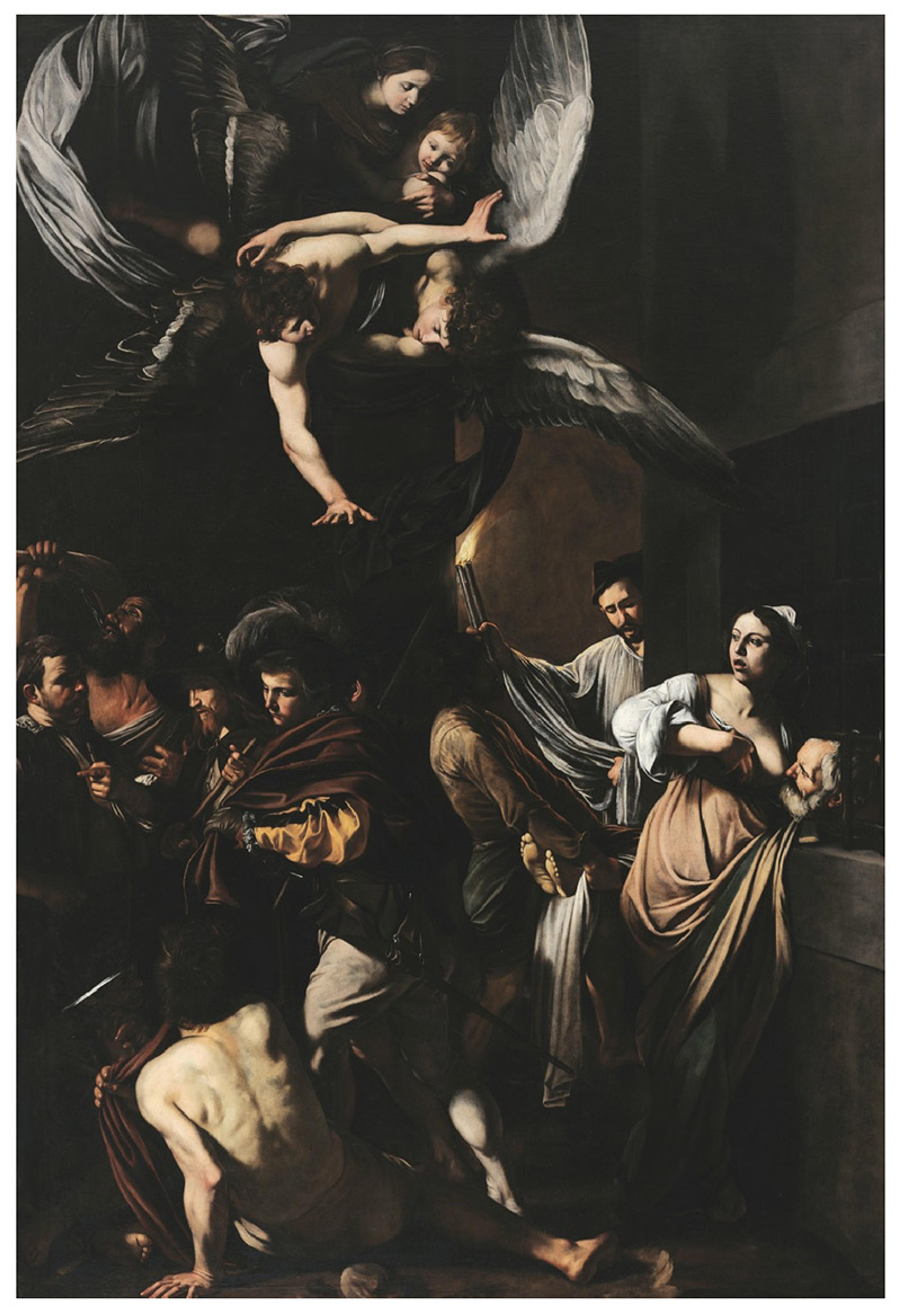
The Seven Acts of Mercy (c1607) by Caravaggio. Courtesy the Pio Monte della Misericordia, Naples, Italy
Perhaps the greatest Baroque painter was Caravaggio, and he was commissioned to do an altar piece, The Seven Works of Mercy (c1607), for a church in Naples, in which he included a depiction of Roman Charity. Caravaggio’s famed use of chiaroscuro, or contrasting light and dark, gives an intense sense of drama to his paintings, but in his version, unlike that of Rubens or most other painters at the time, Pero stands in the street and feeds her father through the bars of his prison while crowds swirl around her. This makes Pero’s law-breaking gift of sustenance both defiant and subversive, transforming a private act of charity, suffused with eroticism and shame in most depictions, into a civic act of solidarity.
The daughter’s breast, nurturing and erotic, distracts us from patriarchy’s blind spot: male need

Roman Charity (c1645) by Gaspar de Crayer. Courtesy the Epiarte Collection/Wikipedia
The increasingly naturalistic depictions of bodies in classical subjects give the Baroque paintings of Roman Charity a pronounced sexual frisson, dissolving the increasingly faint lines that separated the sensual from the sacred. In Gaspar de Crayer’s rendition, the expression on Pero’s face as she performs the abject act of suckling her seated father is complex. Shame and entrapment, duty and love, as she approximates that intentional stillness that mothers learn to adopt in order to facilitate the milk flow. His expression is one of satiated bliss. For me there is a reckoning with this image, churning up my own discomfit with my father’s increasing dependence as he ages, and throwing into sharp relief the impossibility of both giving succour and of eliding that giving, so that the illusion of masculinity’s omnipotence can be maintained.

Roman Charity (1623) by Hendrick ter Brugghen. Courtesy the Met Museum, New York
The Dutch painter Hendrick ter Brugghen has Pero kneeling before her father. She is in the position of supplicant and of the sexually dominant woman, which the Beham brothers parodied. In this painting, the daughter’s indentured care-labour, filial duty and the erotic are entwined. The composition of the painting draws one’s gaze to this illuminated young beauty’s bare shoulders, her rich brocade sleeves tumbled to her elbows. Only then does the viewer’s eye travel to her feasted-upon breast. The suckling old man is swaddled in velvety crimson. As is typical of the Baroque, the illuminated couple is set against a dramatically dark background, so it takes a while to discern the shadowy figure of a man staring at this furtive scene. The two guards of the original account have become a single voyeur who watches the pair as the viewer – we – watch them from the other side of the canvas.
In both these paintings, as with the Rubens, the daughter’s breast, nurturing and erotic, distracts us from patriarchy’s blind spot: male need, dependence, vulnerability. There is the explicit danger that Pero might be caught breaking the law by feeding Cimon, but to save her father she must break an unwritten law. This taboo is not the prohibition against incest. It is the prohibition of an elemental truth of patriarchy: that for this familial, social and cultural system of power and dominance to function, there has to be a denial of the dependence of men on the care given to them by women – that dependence, as the psychoanalyst Donald Winnicott wrote, is the origin of men’s fear of women.
What, I wondered, did women painters, contemporaries of these men who had little truck with female autonomy and even less with female creativity, make of Caritas Romana? To find answers, I turned to the contemporary of these men, Artemisia Gentileschi. Taught to paint by her father, she had a successful and lucrative career that afforded her considerable independence. But this stellar career was scaffolded on great personal courage. Aged 17, Gentileschi was raped by the painter Agostini Tassi, a friend of her father. Tassi was charged and Gentileschi’s testimony ensured that he was convicted, at a cost of being tortured in court to verify the truth of her account.
,_Artemisia_Gentileschi.jpg?width=3840&quality=75&format=auto)
Susanna and the Elders (c1610) by Artemisia Gentileschi. Courtesy Schloss Weißenstein/Wikipedia
Gentileschi made female rage and power a theme in her richly coloured, intense renderings of classical subjects. Her work is fascinating because of the autobiographical elements that represent classical myths from a violated woman’s point of view. Her painting Judith Slaying Holofernes (c1612-13) allegedly depicts Gentileschi killing Tassi, her rapist. She understood only too well the power of the male gaze to strip a female subject of more than her clothes. In her painting Susanna and the Elders (c1610), Gentileschi chillingly depicts the bathing Susanna’s experience of the predatory male gaze and the collusion between two men, so like the leering guards in Rubens and ter Brugghen’s Caritas Romana, spying on a woman in a deeply private, intimate moment.
For him to live he must regress to the position of infant. Emasculation is the price of his salvation
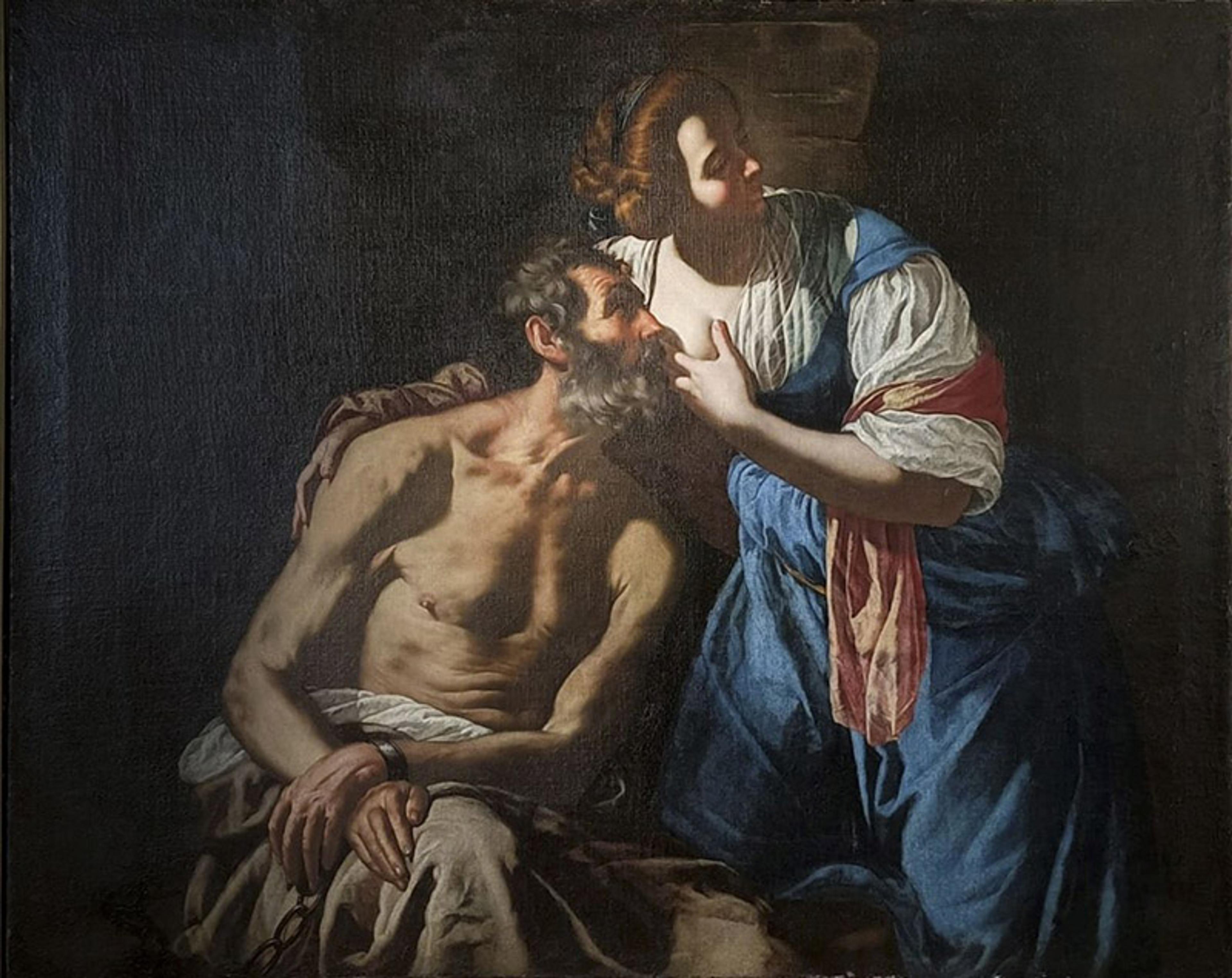
Caritas Romana (c1650s) by Artemisia Gentileschi
Gentileschi’s Roman Charity is different. Pero, large, protective and clad in the regal blue of the Madonna, calmly scans the darkness surrounding them, while her chained old father, naked from the waist up, feeds. The artist has banished the voyeur-guards, so brilliantly rendered in Susanna and the Elders, from the scene. Instead, there is urgency and defiance in this woman giving a life-saving and subversive gift to her father, and Pero is not ashamed. Like Gentileschi’s Judith, Pero is in charge of what she is doing. Like Judith, she holds the power of life and death over a man – but, in this scene, she gives life, not death. To save him, Pero gives of her own body, but for him to live he must regress to the position of infant. Emasculation is the price of his salvation. Gentileschi’s Cimon is aware of his vulnerability, his indebtedness and his dependence. It is this knowledge, perhaps, that makes Gentileschi’s rendition so moving. She reclaims the heroic aspect of caring for another. Her painting allows us to glimpse a counternarrative to the reductive functionalism that collapses a woman’s entire identity into her feeding role, inducting us into a system of kinship based on reciprocity, rather than extractive servitude. Her painting seems to demonstrate, not so much what the daughter’s debt might be to her father – something that she must avert her eyes from – but, rather, what the father’s debt might be to his daughter.
With the changing ideologies of the Church, the state, the family and its sustenance, not to mention the new restraint of neoclassicism, Caritas Romana receded from view, as did wetnursing. In the second half of the 18th century, ancient patterns of wetnursing – nonmaternal breastfeeding and the open-ended forms of kinship made possible by connection via the flow of milk – came under sustained ideological attack. Jean-Jacques Rousseau argued vociferously against wetnursing, writing in Émile (1762) that the first duty of a mother is to feed her own infants. Milk production was being privatised and brought within the domestic confines of the bourgeois patriarchal household.
As breastfeeding became increasingly hidden from view, so renditions of Roman Charity were rarer. Tantalisingly, the Swiss history painter Angelica Kauffmann – a founding member of the Royal Academy in London – painted one in 1794 but, apart from an anodyne sketch from around 1765, which has echoes of Caravaggio, it has been lost.
Then I chanced on Barbara Krafft’s Count Franz de Paula Graf von Hartigand his wife Eleanore as Caritas Romana (1797) – a painting I can view only through the lenses of psychoanalysis and pornography.
.jpg?width=3840&quality=75&format=auto)
Count Franz de Paula Graf von Hartig and his wife Eleanore as Caritas Romana (1797) by Barbara Krafft. Courtesy the National Gallery, Prague/Wikipedia
Krafft distils and surfaces the claustrophobic horrors of the patriarchal bourgeois family that shackles a woman, body, mind and soul. All pretence at the mythic or the allegorical has been dropped, except in the title. This version of Caritas Romana reveals the truth of bourgeois marital arrangements – that the daughter/wife is there to feed and succour her father/husband. The ageing count with his claw-like hands protruding from the sleeves of his striped dressing gown, a tea tray on the table beside him, is propped up like an invalid on plump green cushions, his face turned to us.
A hostage-housewife, she looks straight to camera, unable even to plead her part
The voyeuristic guards are gone. We, the viewers of this ghastly scene, have taken their place and are gawping at the female prison that is the domestic sphere. This uncanny tableau exposes what is usually hidden behind the walls of a home where, in the patriarchal family romance, the daughter and her equivalents service the insatiable, hidden needs of the father. The perversity – a skin-crawling creepiness – exudes from the visual inversion of patriarchal hierarchies of sex/gender and power/dominance. The young daughter/wife, whose full breasts are exposed presumably on her husband/father’s instruction, looks out at us, as does he. He is smug, replete – has he just fed off her? But she looks sick as she stares at us with an expression of defeat, shame and humiliation that is almost unbearable. All of Eleanore’s – all of a woman’s – milk, personhood and dignity have been appropriated.
Here, Krafft has depicted a kind of neoclassical revenge porn in which the nakedness of the woman is put on display at the behest of the man who owns her. This Pero has the blank-eyed stare of a woman who, because she cannot escape, has absented herself. A hostage-housewife, she looks straight to camera, unable even to plead her part. Her ageing husband/father smiles out at us, utterly shameless, while her whole body is freighted with shame. And shame is what has kept so many women silent down the years. It is enforced silence that maintains the patriarchal status quo.
This unsettling painting is layered with future history, but it is also a record of its time. Perhaps Krafft had read Mary Wollstonecraft’s A Vindication of the Rights of Woman (1792), published five years before this painting was completed. Surely, Krafft had heard of The Declaration of the Rights of Woman and of the Female Citizen (1791) by Olympe de Gouges. ‘Women have the right to mount the scaffold,’ declared Gouges. ‘They should likewise have the right to mount the rostrum.’ Krafft would likewise have known that Gouges was sent to the guillotine in 1793, in part because of her insistence on a woman’s right to public speech. Something that Eleanore, wife of Count Franz de Paula Graf von Hartig, did not have.
My historical quest for traceries of Roman Charity achieved its mercenary apotheosis in the late 18th century, when the gendered domestic extraction of female care shifts to the colonial canvas to represent the extraction of resources from colonised subjects. Nowhere is this more evident than in Jean-Michel Moreau’s version of Roman Charity from 1777. Depicted with a colonised subject performing the filial act, Moreau’s image demonstrates the versatility and political resonance of the ancient allegory. A Spanish priest, Bartolomé de las Casas, is cast in the role of the languishing Cimon, who becomes a bedridden invalid, rather than a starved convict. An unnamed woman (whom Sperling in her book calls an ‘Amerindian princess’) is placed at the centre of the composition, near-naked – suggesting that she will play the role of Pero and suckle this sickly man. The painting underwrites the colonial entitlement to the bodies of others, while shifting Caritas Romana’s gendered domestic extraction of female care and labour to the extraction of resources from the colonised world.
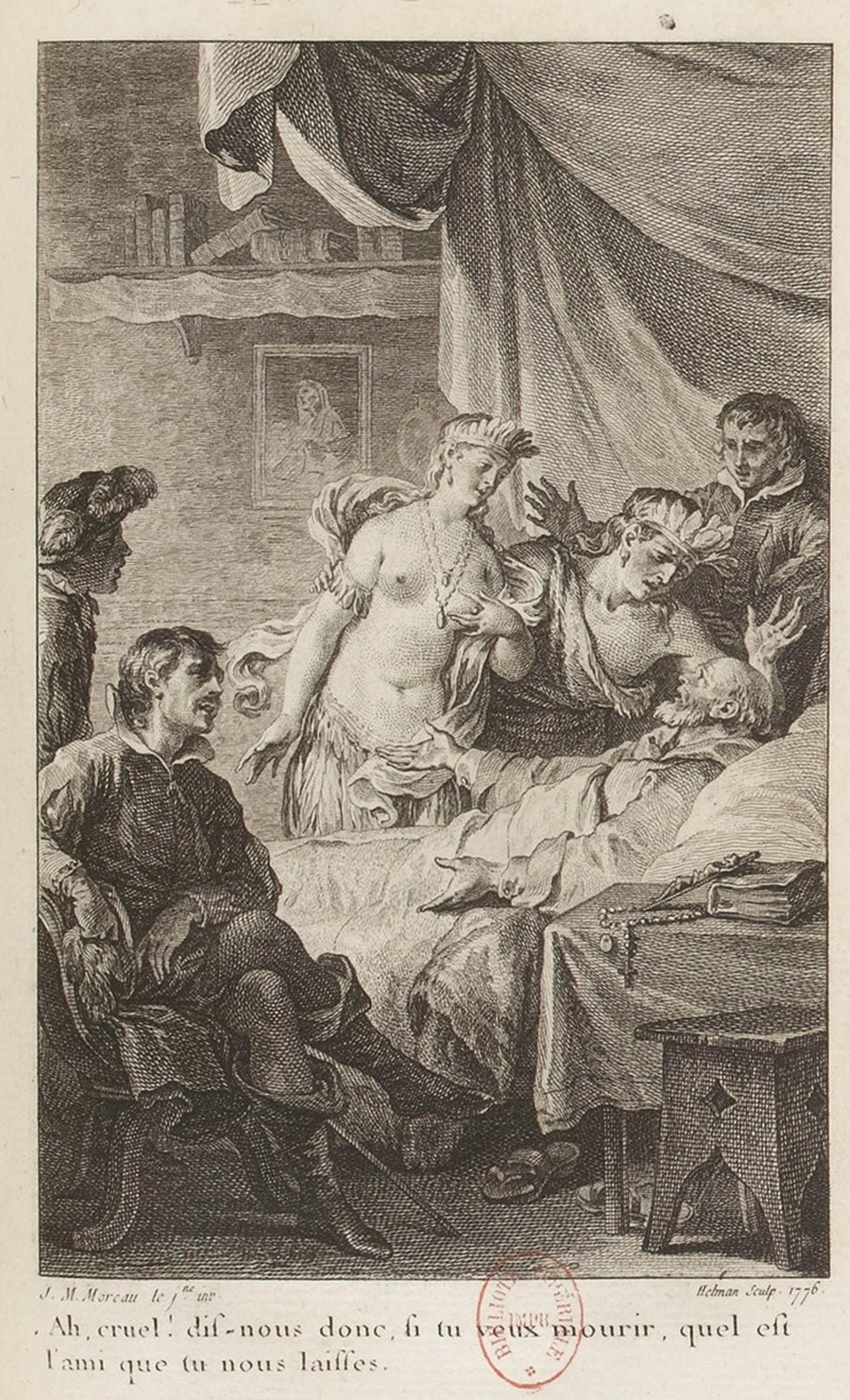
Roman Charity (1777) engraving by Jean-Michel Moreau from Les Incas, ou La Destruction de l’Empire de Pérou. Courtesy the Bibliothèque nationale de France, Paris
This is an image of how gendered extraction without limit and the violence of colonial subjugation are merged and made domestic, intimate, natural. This impossible relation must be kept hidden in the most private spheres – a sphere that, under patriarchal arrangements of the home and the body, is outside of regulation.
And then Roman Charity as a subject of painting disappeared. It took more than 200 years before it burst back, waking like some kind of malignant Sleeping Beauty, onto the visual landscape that is the movie Mad Max: Fury Road (2015). In this eco-apocalyptic world, ruled over by brutal tyrants, Earth has become a man-made desert. Almost all women have been subjugated. There is virtually no water, and nothing grows, so the only food is breastmilk. Because the warlords depend on breastmilk, the women are captive, forced into pregnancy and then, after they give birth, they are hooked up to machines that milk them as dairy cows are milked.
The rebellion against this patriarchal terror is led by a warrior woman, Imperator Furiosa (played by Charlize Theron). Her fight for survival becomes a war between the sexes when she protects a group of escaped women who have miraculously saved the seeds of once-abundant plants. This is the food that will save humanity and liberate women from reproductive enslavement, if only Furiosa can succeed and vanquish Roman Charity forever, freeing Pero from her parasitic father. Once again, Caritas Romana pops up as shorthand for ongoing gendered inequality. We should keep a close watch for its reappearance in the cultural landscape if we want to rethink the politics of filial duty, care and the use-value of women’s bodies.
